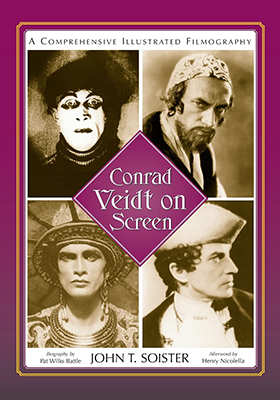
Books on the silent era of cinema.
Copyright © 1999-2025
by Carl Bennett
and the Silent Era Company.
All Rights Reserved. |
|
Conrad Veidt
on Screen
A Comprehensive
Illustrated Filmography
By John T. Soister
|

|
BOOK REVIEW
Conrad Veidt on Screen: A Comprehensive Illustrated Filmography
By John T. Soister
McFarland & Company Inc. : Jefferson, North Carolina : 2002
Hardcover Edition : ISBN 978-0786412891 : 344 pages
$65.00
Trade Paperback Edition : ISBN 978-0786445114 : 344 pages
$39.95
Reviewed by Carl Bennett
|
|
Known chiefly to classic film buffs as Major Strasser from Casablanca (1942) and to silent film enthusiasts as Cesare the somnambulist from The Cabinet of Dr. Caligari (1920), Conrad Veidt achieved popular success and critical accolades in a diverse series of roles in Europe and America throughout his career of more than 100 films, spanning the years 1917 to 1943. Fans of the silent era, in particular, savor his surviving performances in Unheimliche Geschichten [Weird Tales] (1919), Das indische Grabmal [The Indian Tomb] (1921), Das Wachsfigurenkabinett [Waxworks] (1924), Orlacs Hände [The Hands of Orlac] (1924), Der Student von Prag [The Student of Prague] (1926), The Beloved Rogue (1927) and The Man Who Laughs (1928). But Veidt wasn’t exclusively utilized in eerie and villainous roles. A leisurely perusal of the nearly 300-page-long filmography reveals a number of straight-forward roles and even some romantic leads for the lean and surprisingly tall (6' 3") German actor. So, who was this man who brought so many beloved character roles to life on the screen? Well, other than an introductory 19-page Veidt biography written by Pat Wilks Battle, that isn’t the purpose of the book at hand.
John T. Soister has compiled as complete a Conrad Veidt filmography as can be expected for many years to come. Eschewing questionable and outright erroneous Veidt filmographies, Soister has done an admirable job of researching contemporary sources for information on casts and crews, release and censorship details, and synopses and reviews, along the familiar lines of other quality filmographies. Some listings include a concluding section of notes about the film being detailed, where Soister might provide miniature biographies of fellow players or crew, or might point up conflicting or spurious details that are the bane of cinema historians. While many film enthusiasts will want this book for its production information alone, the reviews and synopses will be invaluable for giving the reader an inkling of the content and themes of Veidt’s more than 40 early German films that are thought to be lost forever, including the deliciously intriguing 1918 version of Das Tagebuch einer Verlorenen [Diary of a Lost Girl].
We do have a minor nit to pick with this and some other filmographies. While, the author is quite familiar with their subject, the reader may be coming to this information for the first time. The decision to list the actor, who is the subject of the filmography, first in the cast list — regardless of the importance their role in the film — only serves to introduce some confusion in the minds of readers. Certainly the actor was not the star in every single film they appeared in. So, we lobby for the filmography practice of listing cast members roughly according to the importance of their role to the story, to give some sense of the hierarchy of players and the development of the subject’s career. Soister lists Veidt first in cast lists for each film.
In keeping with many of publisher McFarland’s books on cinema, this filmography is profusely illustrated with production stills, frame enlargements, and reproductions from advertising, posters, heralds and postcards. The quality of the paper and the fine-halftoning of photographs ensures clear and detailed reproduction of the illustrative matter thoughout the book.
Despite the institutional pricing of this volume (and this book should be considered essential for university and public library collections), we feel that cinema enthusiasts will enjoy reading, and benefit from, the information gathered in this filmography of one of the screen’s most admired character actors. Conrad Veidt on Screen may be ordered directly from the publisher at 800-253-2187, or by visiting their website at www.mcfarlandpub.com.
|
|
This book is available directly from . . .
|

|
|




































